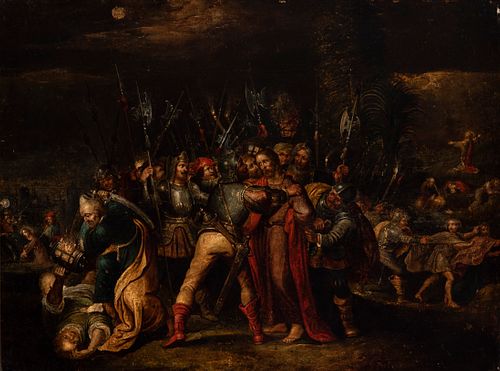Flemish school of the seventeenth century. Attributed to FRANS FRANCKEN II (Antwerp, Belgium, 1581 - 1642). "The kiss of Judas". Oil on panel.
Lot 54
About Seller
Setdart Auction House
Carrer Aragó 346
Barcelona
Spain
Setdart Subastas was born in 2004 and is currently the first online art auction in Spain with solidity, prestige and reliability guaranteed by our more than 60,000 users. Setdart has a young, dynamic and enterprising team ready to successfully manage the purchase and sale of art works through custom...Read more
Estimate:
EUR€2,500 - EUR€2,800
$2,717.39 - $3,043.48
Absentee vs Live bid
Two ways to bid:
- Leave a max absentee bid and the platform will bid on your behalf up to your maximum bid during the live auction.
- Bid live during the auction and your bids will be submitted real-time to the auctioneer.
Bid Increments
| Price | Bid Increment |
|---|---|
| EUR€0 | EUR€10 |
| EUR€200 | EUR€25 |
| EUR€500 | EUR€50 |
| EUR€1,000 | EUR€100 |
| EUR€3,000 | EUR€200 |
| EUR€5,000 | EUR€500 |
| EUR€10,000 | EUR€1,000 |
| EUR€20,000 | EUR€2,000 |
| EUR€50,000 | EUR€5,000 |
About Auction
By Setdart Auction House
Jul 14, 2021
Set Reminder
2021-07-14 06:30:00
2021-07-14 06:30:00
America/New_York
Bidsquare
Bidsquare : OLD MASTERS
https://www.bidsquare.com/auctions/setdart-auction-house/old-masters-7202
Setdart Auction House sofia@setdart.com
Setdart Auction House sofia@setdart.com
- Lot Description
Flemish school of the seventeenth century. Attributed to FRANS FRANCKEN II (Antwerp, Belgium, 1581 - 1642). "The kiss of Judas". Oil on panel. With period frame. Measures: 55 x 73 cm; 71,5 x 89 cm (frame). For its technical and formal characteristics, the work that occupies us could have been made by the hand of Frans Francken, the most fruitful of the lineage of the Francken. In it, the artist shows us the Gospel episode of the kiss of Judas: according to the Gospels, Judas Iscariot betrayed Jesus of Nazareth in the Garden of Gethsemane by means of a kiss. This decisive moment in the life of Jesus is represented by Francken in a completely baroque manner. Thus, we find ourselves in front of an image full of characters, with a totally variegated composition full of narrative. The most fruitful of his family of painters, he trained with his father, Frans Francken I, and in 1605 he joined the Painters' Guild of St. Luke in Antwerp, thus beginning a career that would last until 1640, when he specialized in cabinet painting. His contribution to this genre was of great importance, influencing artists such as Teniers. His style is based on that of Jan Brueghel de Velours, although it also shows strong influences of his father and his uncle, Hieronimus Francken. In his early works, debts to Mannerism and 16th century painting can be seen, both in the structure of the compositions and in the rhythm and expression of his figures. They also include evident references to the work of Italian artists such as Raphael, Veronese and Zuccaro. Likewise, the use of prints by Dürer and Lucas de Leyden for some of his figures has been demonstrated. In addition to cabinet painting, Francken painted mythological and biblical themes, some altarpieces and, in collaboration with other artists, painted the figures in landscapes or interior scenes of Tobacco. in landscapes or interior scenes by Tobias Verhaecht, Joos de Momper II, Pieter Neefs or Paul Vredeman de Vries, among others. He is currently represented in the most important art galleries in the world, such as the Prado Museum, the Louvre, the Royal Museum of Fine Arts in Antwerp, the Kunshistorisches Museum in Vienna, the Hermitage in St. Petersburg and the Royal Collection in London, among many others.
- Shipping Info
-
In-house shipping available. Please inquire at admin@setdart.com.
-
- Buyer's Premium



 EUR
EUR CAD
CAD AUD
AUD GBP
GBP MXN
MXN HKD
HKD CNY
CNY MYR
MYR SEK
SEK SGD
SGD CHF
CHF THB
THB













